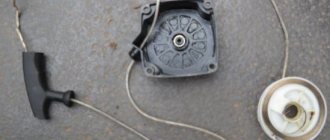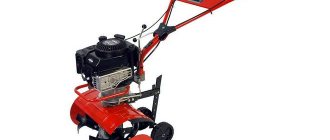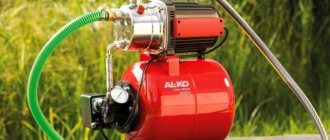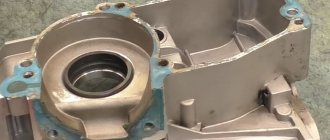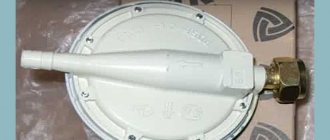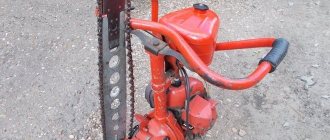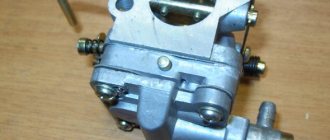Repairing or cleaning and adjusting the carburetor of a chainsaw is one of the most common reasons for contacting our workshop. Almost all carburetors have the ability to independently adjust the operating modes of the chainsaw. Two screws are responsible for the idle and operating speeds of the chainsaw. It is worth considering that the factory settings of a chainsaw carburetor are almost never lost due to vibration, and deeper interventions into the structure of the chainsaw carburetor are required.
If the chainsaw does not start, does not pick up speed, and a strong smell of gasoline appears, it is advisable to contact a workshop for qualified chainsaw repairs . After all, the carburetor is made of many small parts, fuel supply membranes made of thin material, which are easy to lose or damage even for a person with experience and a full hand.
It is also worth noting that the carburetor is only one part of a complex tool, with many components that can only work together. Even minor damage to the fuel hoses, tank, valves and various gaskets leads to air leaks and, as a result, lack of supply of the combustible mixture to the cylinder-piston group of the chainsaw.
Necessary skills and tools for repair
Most of the malfunctions of gasoline chain saws can be fixed with your own hands. True, this requires an understanding of the structure of the chainsaw and how the components function among themselves. As for the tools, the most often needed are:
- screwdrivers (slotted and power);
- combination wrench included in the kit or regular wrenches with heads of various sizes.
Troubleshooting muffler problems
If the chainsaw engine operates normally at low speeds, but starts to stall and smoke at high speeds, the problem may be hidden in the muffler.
To check the quality of its work you should do the following:
- dismantling (with mandatory closing of the outlet);
- disassembly (if the muffler is dismountable);
- cleaning from carbon deposits using special detergents or the dry method;
- drying (using a hair dryer);
- reassembly and installation.
To prevent clogging of the muffler during operation of the chainsaw, you should carefully monitor the composition of the fuel mixture and the quality of its components.
Engine
In most cases, the following problems occur in engine operation:
- the engine stopped starting;
- the engine starts, but after a while it stalls;
- the engine is not able to develop the required power;
- The engine is extremely unstable.
How to check crankshaft seals
The presence of oil seal leaks can only be checked by getting to the crankshaft itself and carefully examining it for leaks. You can see how to do this correctly in the video:
How to check compression on a chainsaw
At a compression level below 8 atmospheres, the engine will not have enough power, which means the chainsaw will not be able to fully function.
To measure compression you need:
- Remove the protective cover and unscrew the spark plug.
- Insert the tip of the compression gauge into the hole where the spark plug should be located.
- Using the starting cord, rotate the piston and remember the maximum readings of the measuring device.
How to properly install a piston on a chainsaw
The work of replacing the piston for most models of modern chainsaws is carried out according to the following algorithm:
- The top and side covers are removed.
- The candle is unscrewed.
- The stoppers are removed from the shock absorbers and the handle is disconnected from the body.
- The drive sprocket and starter are removed.
- A piston stopper is installed in the spark plug hole and the nut securing the flywheel and clutch is unscrewed.
- The flywheel, clutch, and worm drive of the oil pump, located immediately behind the clutch mechanism, are removed.
- The screws securing the carburetor and air filter are unscrewed, after which these components are removed along with the engine control lever.
- The ignition coil is removed, as well as the muffler.
- The saw is turned upside down and, by unscrewing the screws securing it to the body, the engine is disconnected.
- The pan is unscrewed and the piston is removed.
- Since the piston is removed only together with the crankshaft, to disconnect it it is necessary to remove the retaining rings.
- The old piston is replaced with a new one, but as carefully as possible. This is caused by the high fragility of compression rings.
- The crankcase is put in place, and sealant is used instead of a gasket.
All subsequent actions are carried out according to the reverse algorithm of disassembly.
Chainsaw piston group
The dimensions of the cylinder-piston group are determined primarily by the diameter of the piston, made of heat-resistant aluminum alloy. Regardless of the model, the chainsaw CPG consists of a cylinder, a piston, a holding pin and two clamps.
Chainsaw cylinder mirror
When purchasing a piston chainsaw, you should pay attention to the inner surface of the cylinder, which should be polished and have a glossy shine. If there is damage or scratches, experts do not recommend installing such a cylinder.
In order to increase compression in the working unit and, as a result, increase power, many manufacturers install two piston rings. The chainsaw's compression rings, made of special cast iron, fit tightly to the cylinder, resulting in the tightness of the combustion chamber.
Fuel system
Malfunctions of the fuel system are also quite often the main reason that prevents a chainsaw from working as efficiently as possible. First of all, you need to check the quality of the fuel mixture.
Some owners prefer to use alcohol-containing solutions rather than the recommended brand of gasoline, or add more oil than required.
Gasoline leaks from a chainsaw
If gasoline drops periodically appear on the body of the chainsaw, then it is necessary to check the tightness of the fuel tank. Over time, it may dry out. Or the gasket has become “stiff” and it can no longer perform its direct function.
If full-fledged gasoline streams appear, then there is a high probability that you will have to change the burst hose connecting the carburetor and the fuel tank.
Gasoline does not enter the chainsaw cylinder
There are several reasons why the fuel mixture stopped flowing into the cylinder:
- The air filter is clogged.
- The carburetor settings have been lost.
- The carburetor membrane is no longer intact.
- The channels through which gasoline is transported are clogged.
Chainsaw won't idle
In this case, you should start looking for a problem with the filter elements. For the most part, it is precisely because of the reduced capacity of the air and gasoline filters that the idle speed begins to “float”.
If everything is in order with the filters, then you need to check the components of the gas supply system, and also make sure that there are no spontaneous changes in the carburetor settings.
Structural components of a chainsaw
All chainsaws are similar in structure, regardless of whether they are made in Europe (ECHO, Stihl, Husqvarna) or domestic (Kedr, Ural). Inside the body there are the main elements - the fuel tank and the engine, and outside there is a starter, a handle, a saw part (tire) with a chain. A sharp tug of the cable starts the engine, and it starts the saw blade.
To begin with, we invite you to familiarize yourself with videos that show how a chainsaw works and how it works:
From time to time, malfunctions occur in the operation of the saw, which require disassembly to eliminate. What can happen to such a simple mechanism as a chainsaw? At least the following:
- Stops starting;
- It starts, but soon stops;
- Stops functioning when cutting;
- Loses its power;
Most problems are associated either with interruptions in engine operation (fuel supply system, exhaust system, ignition, cylinder-piston part), or with malfunctions of other systems and components (clutch, chain brake, tire, lubrication system). Let's look at the most common breakdowns and methods for eliminating them.
A serviceable chainsaw starts with one pull and does not fail to cut
Filter
A “rich” or “lean” fuel mixture will sooner or later cause a breakdown. Perhaps even expensive. To prevent this from happening, it would be a good idea to regularly check the filter for abrasions, as well as for breaks in the filter fabric itself.
How to check the fuel filter and replace it
To check the current condition of the fuel filter, you must perform the following steps:
- Remove the fuel hose from the carburetor fitting and direct it into a working container.
- Press the so-called “paging” button several times.
If gasoline flows unevenly and jerkily, then it’s time to install a new filter element. This is done quite simply:
- The fuel tank cap is unscrewed.
- Using tweezers or any other device, the filter itself is removed.
- After disconnecting the old filter, you need to install a new one and lower it into the fuel tank.
How to clean the air filter
If a sufficient amount of air is not supplied, the fuel mixture becomes too rich, which leads to disruption of normal engine operation. Regular purging of the air filter, and in particularly advanced cases, washing in a soapy solution will help avoid such problems.
Please note that washing in acetone, gasoline or other aggressive solutions is not allowed. This may lead to damage to the integrity of the filter element.
Carburetor problems
A special feature of the Shtil chainsaw carburetor is the presence of one screw responsible for setting the idle speed
When using equipment, you should always pay attention to the idle speed. A few simple steps will help you adjust this: checking the air filter, as well as the spark protection grille
It is worth noting that repairing the carburetor of a Stihl chainsaw is considered a labor-intensive process. If for some reason it stops starting, you must do the following:
- open the gas cap and then close it;
- remove and dry the candle;
- ventilate the combustion chamber.
If such actions are unsuccessful, pay attention to the fuel supply air filter and the functioning of the spark plug. If, in your opinion, the problem was caused by a malfunction of the carburetor, then it is best to immediately take the chainsaw purchased with a warranty to service.
This is because disassembling it yourself is quite difficult.
Malfunction of unspecified category
In some cases, owners of chainsaws have to solve more complex problems to fully restore the functionality of their cutting tool.
The chainsaw does not develop full power
In addition to the problem discussed above with a lack of gasoline or air entering the cylinder, the cause of low power may be a clogged muffler.
If you do not periodically clean the muffler clogged with combustion products, then the problem of poor engine power may not be the only one.
Carburetor depressurization and nozzle blockage
Over time, the screws holding the carburetor cover in place can become loose or the gaskets can become unusable. A clogged filter or improper replacement can lead to clogged injectors. All this also negatively affects the operation of the chainsaw and shortens its service life.
To prevent this, it is enough to periodically inspect the saw and, if necessary, evenly tighten the screws.
Chainsaw won't idle
It often happens that after long-term transportation and constant use, a chainsaw refuses to idle smoothly. As a rule, this problem is eliminated by adjusting the carburetor.
You can learn how to properly debug the carburetor from this video:
If the carburetor is tuned like a clock, then you need to check:
- Fuel system. It makes more sense to start with the fuel pump.
- Muffler. There is a high probability that due to the abundance of accumulated soot, the engine cannot function normally.
Chainsaw loses power under load
If during operation the power of the saw disappears somewhere, then the problem should be looked for in the following places:
- In the muffler. It, as you already understood, tends to get clogged.
- In a clogged fuel filter.
- A poorly functioning fuel pump.
Chinese chainsaws
Analogs of European and American brands produced in state-owned factories in China are not much different from the original ones. The build quality and internal filling are almost identical.
However, professionals prefer Europe and America, while summer residents and homeowners give credit to China. Still, the loads when working in a garden or on a plot of land are noticeably different from felling trees.
For short-term and short-term use, the resource of a Chinese chainsaw is quite sufficient. Regarding breakdowns, both are equally susceptible to them.
Repairing a Chinese chainsaw with your own hands is as easy as repairing its European counterparts. The only exception would be major engine repairs, which cannot be done at home.
In any case, disassembling and assembling the unit, without having special knowledge, must be carried out according to the instructions attached to it. Working carefully, slowly and carefully.
Malfunction of other systems
In some cases, chainsaw users report other problems that do not significantly affect the operation of the tool.
Why does a chainsaw smoke?
Most often, excessive smoke appears when oil is added excessively to the fuel mixture, which does not have time to burn completely. You should also check to see if the carburetor settings have gone wrong.
Recoil when starting a chainsaw
In most cases, recoil at the moment of startup signals the decompressor clamping. If the tool is not equipped with a decompressor, then most likely the ignition system is faulty.
Malfunctions of Chinese chainsaws: review of popular ones and ways to solve them
Buying a cheap chainsaw made in China is not particularly difficult: a huge number of gas-powered tools from the Middle Kingdom are available in markets, construction hypermarkets and online stores. However, a low price almost always hides poor quality.
The most popular malfunctions of Chinese chainsaws include:
- Poor performance of the lubrication system. Clogged oil channels are cleaned, and if the oil pump fails, replacement is necessary.
- The starter cable breaks.
- Breakage of the plastic starter axis. To replace it, a regular metal bolt will do.
If there is the slightest suspicion that the chainsaw is not working properly, you should immediately carry out a full diagnostic of the tool. Only with proper operation and timely maintenance can you count on a long service life of the chainsaw.
Advantages of Garden Service
- Delivery of equipment for repair and back after completion of work;
- Consultations on issues of interest;
- Large warehouse of components and components allowing to reduce service time;
- Use of original parts, which increases the service life of the tool;
- Cash or non-cash payment options;
- Discounts for regular customers.
If you need chainsaw repair, ignition coil repair or other component, call us at the number. Our employees will advise you, make an appointment for service, and also pre-calculate the cost of repairs.
Why choose Garden Service
Qualified technicians will fix the problem regardless of its complexity. We will carry out high-quality repairs of the chainsaw pump or repair of the chainsaw starter spring. The craftsmen will quickly repair the chainsaw starting mechanism, dismantle parts, replace broken or worn parts, and clean off any remaining oil.
We also provide on-site service. Our master will promptly come to you and carry out the necessary manipulations. If the breakdown is complex, the tool is delivered to our workshop. We have our own component warehouse, where the necessary spare parts are always available. This allows you to eliminate defects of any complexity without wasting time.


